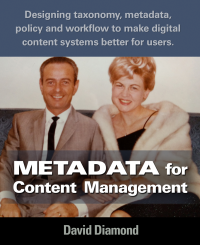 Metadata for Content Management is now available. I wrote it for those who are looking for creative ways to make better use of metadata, taxonomy, policy and workflow in their content systems. The book contains no academic discussions because, well, I’m not an academic. Instead, it’s all about how those topics apply to the management of content using digital systems.
Metadata for Content Management is now available. I wrote it for those who are looking for creative ways to make better use of metadata, taxonomy, policy and workflow in their content systems. The book contains no academic discussions because, well, I’m not an academic. Instead, it’s all about how those topics apply to the management of content using digital systems.
Digital asset management fans might be thrown by the title, but rest assured, this book is for you too. As I mention in the first chapter, we’ve splintered and redefined the terms digital asset management, media asset management, enterprise content management, content management, etc., so often, that they are now meaningless.
It’s all about the management of content. And the systems that do that are, as far as I’m concerned, content management systems. Yes, I know this is what we call WordPress, Drupal and other software in that class. But these systems are about Web publishing, not content management. They’ve enjoyed the moniker content management long enough. It’s time we take that term and apply it to software that is actually capable of managing content.
Readers of DAM Survival Guide should find the new book to be a nice continuation of that discussion, with more emphasis on practical applications than conceptual topics.
Though DAM Survival Guide is not required reading before you can get into Metadata for Content Management, the new book does presume the reader has at least some basic understanding of the goals behind content management.
The groovy people on the cover are my parents. I thought long and hard about what image was most appropriate for a book like this. It occurred to me that because all this content management stuff was about the preservation of the content we value most, I figured a photo of these two wonderful people was suitable.
I hope you enjoy the new book! You can buy it now from Amazon »